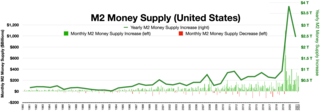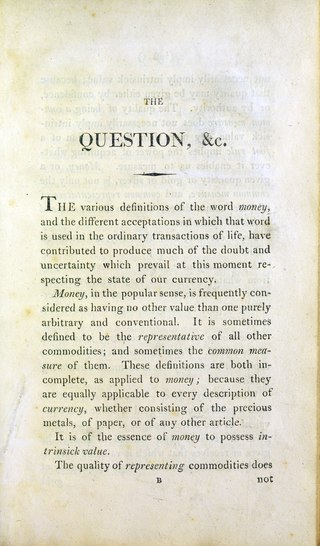Related Research Articles

The euro is the official currency of 20 of the 27 member states of the European Union (EU). This group of states is known as the eurozone or, officially, the euro area, and includes about 344 million citizens as of 2023. The euro is divided into 100 cents.

An interest rate is the amount of interest due per period, as a proportion of the amount lent, deposited, or borrowed. The total interest on an amount lent or borrowed depends on the principal sum, the interest rate, the compounding frequency, and the length of time over which it is lent, deposited, or borrowed.

Monetary policy of The United States concerns those policies related to the minting & printing of money, policies governing the legal exchange of currency, demand deposits, the money supply, etc. In the United States, the central bank, The Federal Reserve System, colloquially known as "The Fed" is the monetary authority.

In macroeconomics, the money supply refers to the total volume of currency held by the public at a particular point in time. There are several ways to define "money", but standard measures usually include currency in circulation and demand deposits. The central bank of a country may use a definition of what constitutes legal tender for its purposes.

Currency substitution is the use of a foreign currency in parallel to or instead of a domestic currency. The process is also known as dollarization or euroization when the foreign currency is the dollar or the euro, respectively.

Monetary policy is the policy adopted by the monetary authority of a nation to control either the interest rate payable for very short-term borrowing or the money supply, often as an attempt to reduce inflation or the interest rate, to ensure price stability and general trust of the value and stability of the nation's currency.
In economics, hot money is the flow of funds from one country to another in order to earn a short-term profit on interest rate differences and/or anticipated exchange rate shifts. These speculative capital flows are called "hot money" because they can move very quickly in and out of markets, potentially leading to market instability.

In public finance, a currency board is a monetary authority which is required to maintain a fixed exchange rate with a foreign currency. This policy objective requires the conventional objectives of a central bank to be subordinated to the exchange rate target. In colonial administration, currency boards were popular because of the advantages of printing appropriate denominations for local conditions, and it also benefited the colony with the seigniorage revenue. However, after World War II many independent countries preferred to have central banks and independent currencies.

A country's gross government debt is the financial liabilities of the government sector. Changes in government debt over time reflect primarily borrowing due to past government deficits. A deficit occurs when a government's expenditures exceed revenues. Government debt may be owed to domestic residents, as well as to foreign residents. If owed to foreign residents, that quantity is included in the country's external debt.
Foreign exchange reserves are cash and other reserve assets such as gold held by a central bank or other monetary authority that are primarily available to balance payments of the country, influence the foreign exchange rate of its currency, and to maintain confidence in financial markets. Reserves are held in one or more reserve currencies, nowadays mostly the United States dollar and to a lesser extent the euro.

Money creation, or money issuance, is the process by which the money supply of a country, or of an economic or monetary region, is increased. In most modern economies, money creation is controlled by the central banks. Money issued by central banks is termed base money. Central banks can increase the quantity of base money directly, by engaging in open market operations. However, the majority of the money supply is created by the commercial banking system in the form of bank deposits. Bank loans issued by commercial banks that practice fractional reserve banking expands the quantity of broad money to more than the original amount of base money issued by the central bank.
An exchange rate regime is a way a monetary authority of a country or currency union manages the currency about other currencies and the foreign exchange market. It is closely related to monetary policy and the two are generally dependent on many of the same factors, such as economic scale and openness, inflation rate, the elasticity of the labor market, financial market development, capital mobility ,etc.
The Convertibility plan was a plan by the Argentine Currency Board that pegged the Argentine peso to the U.S. dollar between 1991 and 2002 in an attempt to eliminate hyperinflation and stimulate economic growth. While it initially met with considerable success, the board's actions ultimately failed. In contrast to what most people think, this peg actually did not exist, except only in the first years of the plan. From then on, the government never needed to use the foreign exchange reserves of the country in the maintenance of the peg, except when the recession and the massive bank withdrawals started in 2000.

In macroeconomics and economic policy, a floating exchange rate is a type of exchange rate regime in which a currency's value is allowed to fluctuate in response to foreign exchange market events. A currency that uses a floating exchange rate is known as a floating currency, in contrast to a fixed currency, the value of which is instead specified in terms of material goods, another currency, or a set of currencies.

Modern Monetary Theory or Modern Money Theory (MMT) is a heterodox macroeconomic theory that describes currency as a public monopoly and unemployment as evidence that a currency monopolist is overly restricting the supply of the financial assets needed to pay taxes and satisfy savings desires. MMT is opposed to the mainstream understanding of macroeconomic theory and has been criticized heavily by many mainstream economists.

Currency depreciation is the loss of value of a country's currency with respect to one or more foreign reference currencies, typically in a floating exchange rate system in which no official currency value is maintained. Currency appreciation in the same context is an increase in the value of the currency. Short-term changes in the value of a currency are reflected in changes in the exchange rate.

Money is any item or verifiable record that is generally accepted as payment for goods and services and repayment of debts, such as taxes, in a particular country or socio-economic context. The primary functions which distinguish money are as a medium of exchange, a unit of account, a store of value and sometimes, a standard of deferred payment.
Original sin is a term in economics literature, proposed by Barry Eichengreen, Ricardo Hausmann, and Ugo Panizza in a series of papers to refer to a situation in which "most countries are not able to borrow abroad in their domestic currency."
Fear of floating refers to situations where a country prefers a fixed exchange rate to a floating exchange rate regime. This is more relevant in emerging economies, especially when they suffered from financial crisis in last two decades. In foreign exchange markets of the emerging market economies, there is evidence showing that countries who claim they are floating their currency, are actually reluctant to let the nominal exchange rate fluctuate in response to macroeconomic shocks. In the literature, this is first convincingly documented by Calvo and Reinhart with "fear of floating" as the title of one of their papers in 2000. Since then, this widespread phenomenon of reluctance to adjust exchange rates in emerging markets is usually called "fear of floating". Most of the studies on "fear of floating" are closely related to literature on costs and benefits of different exchange rate regimes.
The BONEX Plan was a forced conversion of bank time deposits to Treasury bonds performed by the Argentine government in January 1990.
References
- ↑ Calvo, G. A.; Izquierdo, A.; Loo-Kung, R. (2006). "Relative price volatility under Sudden Stops: The relevance of balance sheet effects" (PDF). Journal of International Economics. 69: 231–254. doi:10.1016/j.jinteco.2005.06.008. S2CID 154284114.
- ↑ IDB (Inter-American Development Bank) . 2004. Unlocking Credit: The Quest for Deep and Stable Bank Lending. 2005 Economic and Social Progress Report. Washington, DC, United States: Johns Hopkins University Press and Inter-American Bank.
- 1 2 3 4 Berkmen, S. P.; Cavallo, E. (2010). "Exchange Rate Policy and Liability Dollarization: What do the Data Reveal about Causality?". Review of International Economics. 18 (5): 781. doi:10.1111/j.1467-9396.2010.00890.x. S2CID 154678349.
- 1 2 Yeyati, E. L. (2006). "Financial dollarization: Evaluating the consequences" (PDF). Economic Policy. 21 (45): 62–118. doi:10.1111/j.1468-0327.2006.00154.x. hdl: 10.1111/j.1468-0327.2006.00154.x . S2CID 219722972.
- ↑ Izquierdo, A. "Dollarization and Crises: Ways In and Out: De-dollarization Strategies and Domestic Currency Debt Markets in Emerging Economies." Presentation at Annual Meetings of the Board of Governors of the Inter-American Development Bank. Okinawa, Japan, April 8, 2005.
- ↑ See i) Ize, A.; Yeyati, E. L. (2003). "Financial dollarization". Journal of International Economics. 59 (2): 323. doi:10.1016/S0022-1996(02)00017-X. hdl: 10915/33932 .; and ii) Chang, R.; Velasco, A. S. (2006). "Currency mismatches and monetary policy: A tale of two equilibria". Journal of International Economics. 69: 150–175. doi:10.1016/j.jinteco.2005.05.008.
- ↑ Honig, A. (2009). "Dollarization, exchange rate regimes and government quality". Journal of International Money and Finance. 28 (2): 198–214. doi:10.1016/j.jimonfin.2008.11.004.
- ↑ Calvo, G. A. (February 2007). "Monetary Policy Challenges in Emerging Markets: Sudden Stop, Liability Dollarization, and Lender of Last Resort". NBER Working Paper No. 12788. doi: 10.3386/w12788 .
- ↑ Calvo, G. A.; Izquierdo, A.; Mejía, L-F. (May 2008). "Systemic Sudden Stops: The Relevance of Balance-Sheet Effects and Financial Integration". NBER Working Paper No. 14026. doi: 10.3386/w14026 .
- ↑ Uribe, M. (1997). "Hysteresis in a Simple Model of Currency Substitution" (PDF). Journal of Monetary Economics . 40 (1): 185–202. doi:10.1016/S0304-3932(97)00038-X.
- ↑ Reinhart, C. M.; Rogoff, Kenneth S.; Savastano, M. A. (October 2003). "Addicted to Dollars". NBER Working Paper No. 10015. doi: 10.3386/w10015 .
- ↑ Galindo, A.; Leiderman, L. (May 2005). "Living with Dollarization and the Route to Dedollarization". IDB Working Paper No. 437. Washington, DC, United States: Inter-American-Development Bank. SSRN 1818726.
- ↑ Cavallo, E.A. 2010. "Debt Management in Latin America: How Safe Is the New Debt Composition? IDB Policy Brief #109. Washington, DC, United States: Inter-American Development Bank.